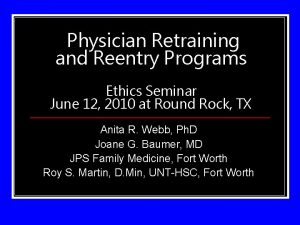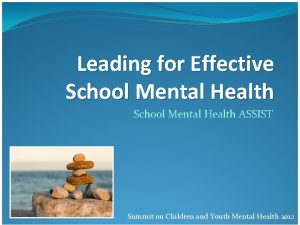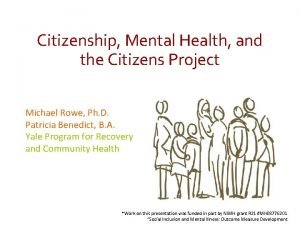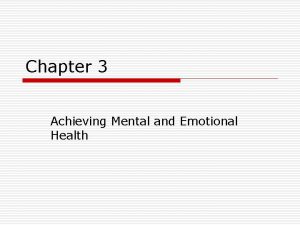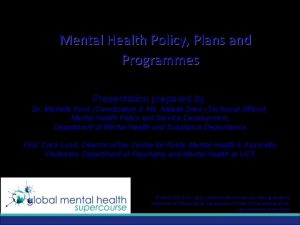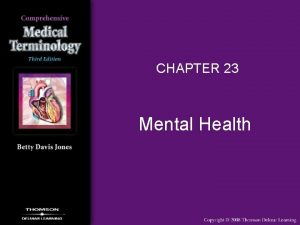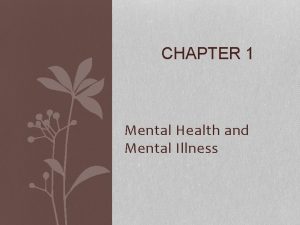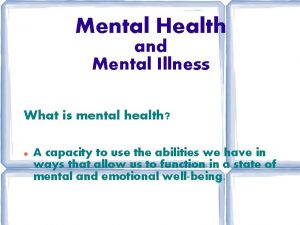Mental Health and Reentry to School August 26




















- Slides: 20

Mental Health and Re-entry to School August 26, 2020 Ms. Magda Bukala Dr. Sivan Erstein Dr. Yeddi Park Dr. Jeanne Rolih

Who we are. Where we are.

School WILL look different • Discuss new rules or practices at school. • Talk about them now, before school starts. Especially with your younger children. • Talk with your child about how school will look

Continuing to decrease the stigma • It is okay to ask for help if you need it. • We are available for kids who are having a tough time, but also for parents who may have concerns.

Talk to your child if he/she is anxious about school. • Recognize that they are afraid • Have honest conversations. • Early middle school children will be vocal with questions about whether they will be safe at school. • Older teens are able to discuss issues in a more indepth fashion.

Keep explanations age-appropriate • Find out what they are afraid about. • Answer their questions • Remind them what the school is going to do to keep students and teachers safe and what rules you’re going to follow as a • Minimize exposure to news and media outlets for younger students. Older teens may need help sifting through information that is credible, fact-based, and helpful. It is important for this age group to have the appropriate knowledge, resources, and support that can help them feel a sense of control.

Anticipate behavior changes • Anticipate some behavior changes in your child especially during the transition back to school. • Many kids will be over tired which can lead to irritability and increased levels of anxiety. Its normal to be slightly nervous about the return to school.

Ways to help a manage anxiety during the transition back to school. • Normalize anxiety • Shift the spotlight • Encourage distractions • Maintain healthy routines • Parents, manage your own anxiety

Practice Bravery • “I would love you to take a walk with me outside. I know that the streets are safe and that it’s okay to walk outside. ” • “I would love you to ride your bike outside. I feel the streets are fine. ” • Reinforce these behaviors.

When should you be concerned? • Watch for changes like EXCESSIVE crying or irritation, EXCESSIVE worry or sadness, unhealthy eating or sleeping habits, or difficulty concentrating. • If you are worried about your child’s anxiety level, reach out to us.

RESILIENCE

SELF-CARE

Compassion Fatigue

TOOLS IN THE TOOLBOX • Deep breathing & Mindfulness (Safe in the body) • Connect, Relate and Cope (Safe in Relationships) • Avoid sedentary life-style • Healthy boundaries • Recognize negativity bias hard wired in to our DNA (Do something enjoyable every day) • Practice empathy and kindness

RIDE THE WAVES

PROVIDE EMOTIONAL GUIDANCE

Preparing at Home for Re -entry to School • Practice safety guidelines: • Wearing masks (pick out cool, comfortable masks); compliment them and praise them for wearing the masks; model the appropriate behavior by wearing masks yourself • Temperature taken each day

Preparing at Home for Re -entry to School • Create a work space for your child in the home • for homework and/or remote learning • Try to remove as many distractions from the work space as possible • Have students participate in getting school supplies and picking out items they prefer

Establishing Healthy Routines • Set daily routines with your child which include both academic and fun activities • write it out or set alarms to facilitate transitions • have your child help with setting up schedule • Program in movement breaks every 20 -30 minutes for younger students or 45 -60 minutes for older students • Adjust bedtime/ wake up time • shut off electronics earlier each night, earlier alarm each morning • Reinforce adherence to the schedule • Positive reinforcement: • Acknowledge your child for following daily routines and transition back to school • Home reinforcement plan if needed

Q&A
 Chapter 20 mental health and mental illness
Chapter 20 mental health and mental illness Mental health jeopardy game
Mental health jeopardy game Tdcj reentry and integration division
Tdcj reentry and integration division Physician reentry program
Physician reentry program J rec
J rec Thor program georgia
Thor program georgia +reentry +case +management
+reentry +case +management Reentry partnership housing
Reentry partnership housing Revive reentry
Revive reentry Idioventrikulární rytmus
Idioventrikulární rytmus School mental health assist
School mental health assist Chapter 3 lesson 3 expressing emotions in healthful ways
Chapter 3 lesson 3 expressing emotions in healthful ways Mental health and older adults
Mental health and older adults Law enforcement mental health and wellness act
Law enforcement mental health and wellness act Mental health and older adults
Mental health and older adults Mental health and citizenship
Mental health and citizenship Chapter 3 achieving mental and emotional health
Chapter 3 achieving mental and emotional health Chapter 21 mental health diseases and disorders
Chapter 21 mental health diseases and disorders Chapter 3 mental and emotional health
Chapter 3 mental and emotional health Psychology, mental health and distress
Psychology, mental health and distress Mental health policy, plans and programmes michelle funk
Mental health policy, plans and programmes michelle funk



